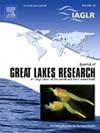Assessing water clarity status and long-term trends in North America’s largest lakes using ESA’s Ocean Colour Climate Change Initiative (OC-CCI) products
IF 2.4
3区 环境科学与生态学
Q3 ENVIRONMENTAL SCIENCES
引用次数: 0
Abstract
Water clarity, as measured by Secchi disk depth (ZSD) or diffuse attenuation (Kd), is an important indicator of a lake’s ecosystem state and can be reliably retrieved using satellite remote sensing. By combining data from multiple satellite missions, the European Space Agency’s Ocean Colour Climate Change Initiative (OC-CCI) aims to deliver stable, long-term, satellite data products suitable for trend assessments. Here we demonstrate the value of OC-CCI products for reporting on water clarity status and long-term trends in North America’s largest lakes. Extensive matchups between the OC-CCI Kd at 490 nm (Kd490) and in situ ZSD observations spanning 25 years enabled robust multi-lake validation of ZSD retrievals over a wide range of water clarity conditions (R2 = 0.9, MAPE = 29.6 %, BIAS = 6.6 %, N = 4297) providing a transferable model for large-scale mapping of inland water clarity. Significant differences in ZSD retrieval uncertainty were observed between years, missions, and specific periods marking changes in the sensor datasets contributing to the OC-CCI products. Bias-correction of the OC-CCI Kd490 provided confidence in the assumption of seamless continuity in this multi-mission dataset, thereby allowing long-term time-series analyses. Seasonal, inter-annual and inter-decadal variability and trends in lake-wide average ZSD were subsequently evaluated for nine large lakes across Canada and the U.S. over the 1998–2023 period, capturing the timing and magnitude of significant shifts in water clarity conditions. Observations agree well with documented periods of ecosystem change in response to the cumulative impacts from harmful algal blooms, nutrient status, invasive species, and hydrological events.
求助全文
约1分钟内获得全文
求助全文
来源期刊

Journal of Great Lakes Research
生物-海洋与淡水生物学
CiteScore
5.10
自引率
13.60%
发文量
178
审稿时长
6 months
期刊介绍:
Published six times per year, the Journal of Great Lakes Research is multidisciplinary in its coverage, publishing manuscripts on a wide range of theoretical and applied topics in the natural science fields of biology, chemistry, physics, geology, as well as social sciences of the large lakes of the world and their watersheds. Large lakes generally are considered as those lakes which have a mean surface area of >500 km2 (see Herdendorf, C.E. 1982. Large lakes of the world. J. Great Lakes Res. 8:379-412, for examples), although smaller lakes may be considered, especially if they are very deep. We also welcome contributions on saline lakes and research on estuarine waters where the results have application to large lakes.
 求助内容:
求助内容: 应助结果提醒方式:
应助结果提醒方式:


